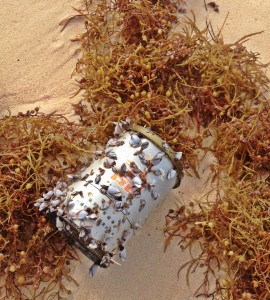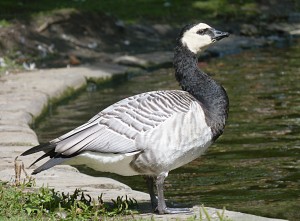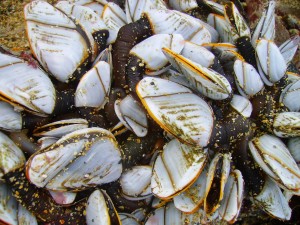by Kristen Minogue
The most bizarre scientific legends sometimes come from completely ordinary creatures. Take, for example, the medieval legend of a tree that gave birth to birds.
A few days ago, marine ecologist Kim Holzer discovered a strange can washed up on a Bermuda beach. Washed-up debris can be dangerous, especially when it comes coated with potential invaders. But this can carried nothing extraordinary—except goose barnacles, the crustaceans that spawned one of the oddest scientific myths in Western history.
Up close, it’s not hard to imagine how the bulbous white shells and black stalks of these barnacles could resemble the neck of a goose. But in the Middle Ages, the particular goose they supposedly took after was a mystery. That bird, Branta leucopsis, overwintered in Ireland and Scotland, but few saw where it nested. When locals found the black and white barnacles floating to shore on pieces of driftwood, the answer seemed obvious. They concluded that the geese did not have nests at all. Instead, these barnacles must be fruit that, when ripe, gave birth to the geese. (Some medieval artwork depicts the strange goose-bearing tree.) Thus the legend was born. The bird became the “barnacle goose”, and the barnacles became “goose barnacles” or, in their early usage, “Bernakes.”
The 12th-century bishop Giraldus Cambrensis was one of the first to put the legend to paper, in his Topographia Hiberniae. The notion that a male goose could spontaneously spring forth from a tree was, in his view, irrefutable evidence of the Immaculate Conception of Christ. Two centuries later, the myth reappeared in the popular book The Travels of Sir John Mandeville, published around 1356:
“I told them of as great a marvel to them, that is amongst us, and that was of the Bernakes. For I told them that in our country were trees that bear a fruit that become birds flying, and those that fell in the water live, and they that fall on the earth die”.
Throughout the Middle Ages, the myth of the barnacle goose–and the goose barnacle “fruit” thought to give birth to it–retained a hold on religious culture. A few Irish clergy saw a loophole in the rule that forbade eating meat of the flesh (any meat other than seafood) during fasting. The “tree-goose”, being spontaneously generated from a plant, was fair game. For Jewish rabbis the issue of whether to eat the birds at all became a serious question. Some rabbis strictly prohibited their consumption, on the grounds that the birds were “vermin” (though whether they were land vermin or flying vermin was open to debate). More liberal rabbis who thought they could be eaten wondered whether, upon consumption, the goose should be blessed as a bird or a fruit.
Even in the Middle Ages there were skeptics, including Albert the Great, who dismissed the legend as “altogether absurd” in the mid-1400s. In 1751 a British naturalist named John Hill published one of the most scathing refutes in a critique of the Royal Society of London, which allegedly published a paper on the topic. (Hill may have been bitter about the society’s decision to reject his application for membership, but his logic in this case was still sound.) Hill attributed the myth to a group ignorant fishermen who mistook the wispy filaments protruding from the barnacle’s shells for feathers.
“About the Shores of the very Places where these Birds are most frequent, there are found also in vast Abundance, a Species of Shell-Fish, peculiar for certain filamentous Substances, frequently seen hanging out at it. The ignorant Fishermen, who found these Shells in abundance affixed to rotten Wood and dead Trees, that were floating in the Water, or lodged by it on the Shore, soon found the Way to confound the filamentous Substances which hung out of them with Feathers, and persuaded themselves, that Geese, whose Origin they could before by no Means make out, were bred from them, instead of being hatched like other Birds from Eggs.
The fact that most 18th-century British had never seen the geese nesting made the superstition more believable. To clear up any questions on that score, Hill included the following admonition:
“As to the Certainty of the Bird being hatched like other Geese, we have not only our Reason to inform us that it must be so, we but have Accounts of Dutch Sailors, who have found immense Numbers of their Nests with the Females sitting on the Eggs, and the Young of somewhat forwarder Broods running about them, and since that, they have been known to breed even with us.”
These Dutch sailors probably traveled to northern Europe, Greenland or the Baltics, where barnacle geese are known to breed today. The barnacle geese that overwinter in Scotland and Ireland nest in northeast Greenland–presumably a place few medieval fishermen or clergy had ever ventured. The unfortunate crustaceans were dragged into the debate purely by circumstance: The egg-resembling goose barnacles were in Ireland and Scotland at the time; the actual goose eggs were not.
But the legend of the goose barnacle hasn’t fully disappeared. It was perpetuated, ironically, by the same scientific community that helped debunk it: The barnacle’s scientific species name, anserifera, literally translates in Latin to “goose-bearing”.
Image of goose barnacles (Sue Langford) used with permission under the Creative Commons license here.





This is deliciously hilarious!! Imagine one doing some study and coming up with such amazing facts.. I laughed at loud and had to share to friends. Amazingly written as well. Thanks for lift my study night 100% up!!